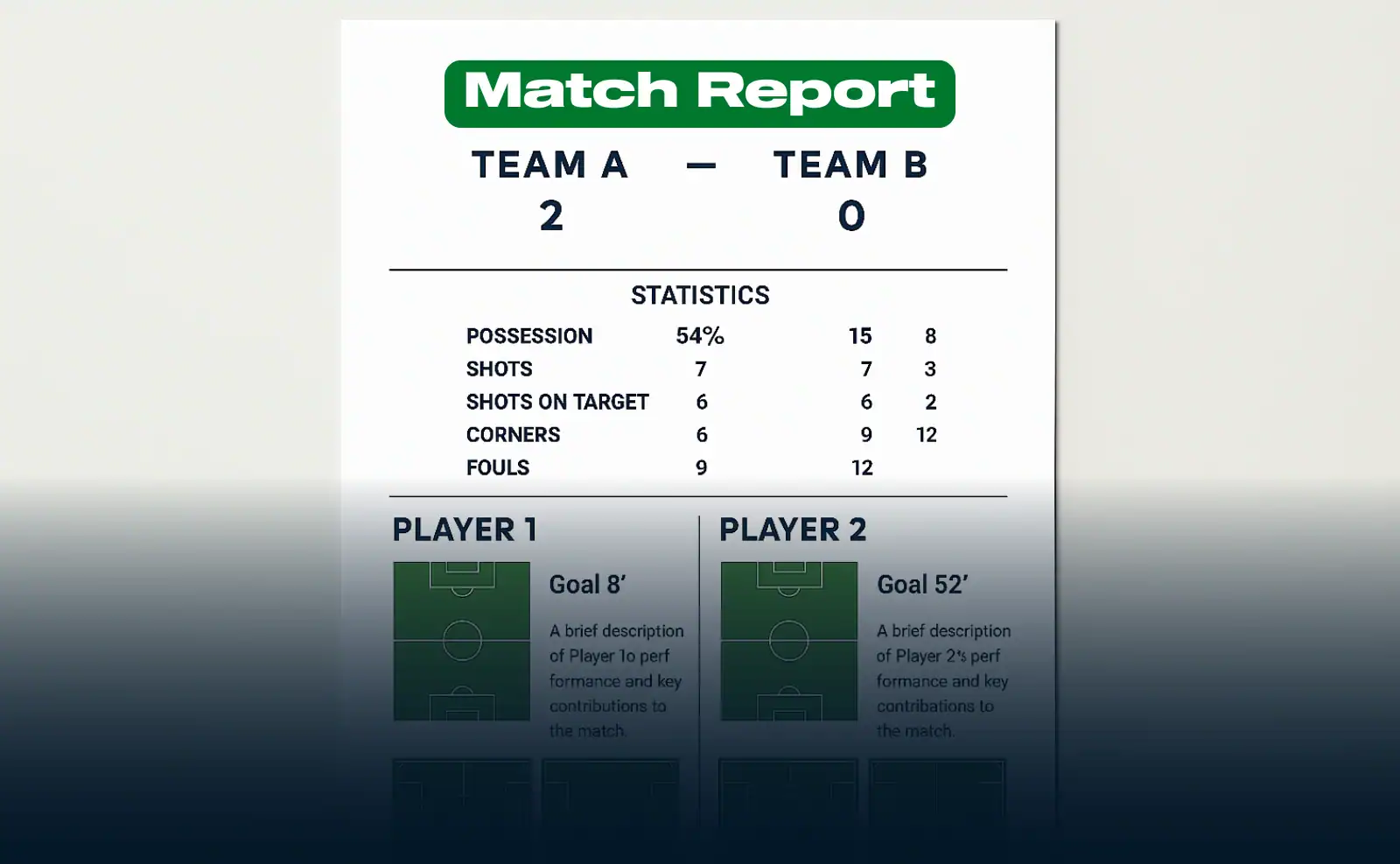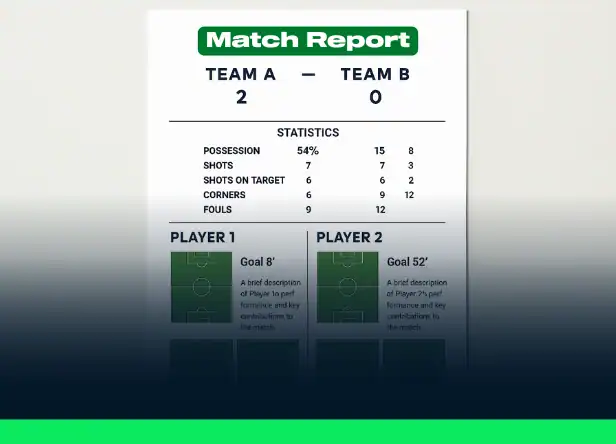The match report of a soccer scout is used to highlight the strengths, weaknesses, profile, and other characteristics of the subject being observed: home team, opponent, a player, a line of players… This guide is here to teach you how to write a soccer match report properly.
What methodology should you use to write a scouting report? What preparation is necessary before the match starts? How do you stay organized while writing your match report and keeping an eye on the game?
What is a soccer scouting match report?
A scouting match report is a concise yet comprehensive dossier that synthesizes live observations of a team, individual players, or positional groups. Its purpose is to highlight technical strengths, tactical understanding, physical attributes, mental characteristics, and any noteworthy tendencies.
So how do you write a soccer match report?
Far from being an easy task, a good match report combines note-taking and analysis techniques to provide a clear and objective overview of the player you plan to recommend to the team you work for.
How do you write a soccer match report as a scout?
Writing reports is one of the most complex tasks for a scout. Here’s how to write an effective soccer match report for your (future) team.
Choosing Your Format: Reports can take different forms, find the one that works for you
There is no single “official” template in U.S. soccer; reports vary by club preference. Common delivery formats include:
- Handwritten notes transcribed post-match
- Standardized PDF or Word templates
- Structured emails with embedded tables
- Excel workbooks with dropdown menus and data validation
- Specialized platforms (e.g., Wyscout, Instat, Hudl)
Pro Tip: Master Microsoft Word, Excel, and your club’s preferred scouting software to ensure seamless data entry and professional presentation.
Writing the report during the match: Pre-Match Preparation
- Scout Sheet Review: Confirm team names, league level, kickoff time, venue, and competition context.
- Player Shortlist: Identify key targets—prospects or opposition players—to monitor closely.
- Observation Point: Secure a vantage point with clear sightlines to both penalty areas and central midfield.
- Note-Taking Tools: Use a consistent shorthand for common attributes (e.g., “CV” for cover, “1v1” for duels, “AP” for anticipated pass).
In-Match Observation Framework
Divide your note-taking into four phases to balance breadth and depth:
| Phase | Time Frame | Focus Area |
|---|---|---|
| Initial Impressions | 0′–25′ | Player roles, formation shape, standout technical traits (dribbling, first touch) |
| First-Half Analysis | 25′–45′+ | Positional discipline, off-the-ball movement, pressing triggers |
| Second-Half Start | 45′–70′ | Substitution impacts, tactical tweaks (width, pressing intensity) |
| Match Conclusion | 70′–90′+ | Key moments from top prospects, stamina and concentration in decisive phases |
During the match
To effectively assess a team or player, your observation and note-taking should follow a structured timeline:
Minutes 0–25:
Focus on identifying each player’s standout traits, particularly those that align with the club’s tactical or positional needs.
Minutes 25–45 (end of 1st half):
Start deeper analysis: how players move, how they behave, and how well they perform their roles on the field.
Halftime:
Quickly review and supplement your notes. Add any insights you missed while actively watching.
Minutes 45–70/75:
Be alert for any tactical changes (substitutions, shifts in formation, etc.).
Final 15–20 minutes:
Narrow your focus to the players who caught your attention earlier. Start selecting the most promising individuals to include in your final report.
Post-Match Report Structure
Scout’s final document should open with match details (date, competition, venue, final score, and notable incidents like penalties or red cards). Follow with subject profiles listing name, squad number, position(s), and a brief physical description (height, build, pace).
The technical assessment section evaluates ball control and passing range, accuracy under pressure, dribbling confidence, preferred foot, and beat-rates in 1v1 situations. In the tactical and game intelligence portion, discuss positioning, lines of passing, spatial awareness, defensive work-rate—including pressing intensity and recovery runs—and transitional play such as speed of circulation and link-up combinations.
Psychological traits like communication, leadership, and response to setbacks should be described in narrative form, supported by specific examples (for instance, “Success rate 4/6 under-pressure passes”). Conclude with a balanced summary of the top three strengths and three areas for improvement, then provide your overall recommendation—such as “Highly recommended for U-18 academy” or “Requires further evaluation in higher tempo environments.”
How to write a scouting match report: What to remember
Keeping Organized under Pressure
Real-time clarity is essential. Consistently employ your predetermined shorthand and think about creating boxes for each player or positional unit or a grid-based note sheet. Using colored pens or markers, a basic highlighting system can enable you to quickly identify unusual or worrisome acts, therefore lowering your chance of missing important findings.
Frequent Mistakes and Ongoing Development
Focus on your top topics and resist over-commenting on every player. Make sure evidence backs up subjective comments. Typos and grammatical mistakes damage credibility; hence proofread your report before publishing. Enroll in accredited scouting classes addressing industry-standard reporting tools and techniques to sharpen your abilities, then increase your familiarity with video-analysis software like Wyscout or Scout7 and solicit peer reviews of draft reports to improve clarity and tactical insight.
Following this systematic approach—from extensive pre-match study and in-match synthesis to unambiguous post-match reporting—you will provide scouting evaluations that support your team, identify talent, grasp tactical nuances, and make wise choices.
Conclusion: Match Report Writing for Professionals
As a professional player scout, knowing how to write a soccer match report is an integral part of the job. A few rules not to forget when learning how to write a soccer match report:
- Take care with your spelling — mistakes can discredit you!
- Have a rigorous methodology to analyze matches and write your reports
- Learn how to identify the best players based on the club’s sporting instructions
- Be concise and get straight to the point
The best way to learn how to write a proper match summary is by taking a certified training course. Beyond teaching you how to produce professional match reports, it covers the entire profession (e.g.: learning how to use scouting software, knowing what to observe in a soccer match) and, once certified, allows you to find a professional club where you can work and showcase your talent.





